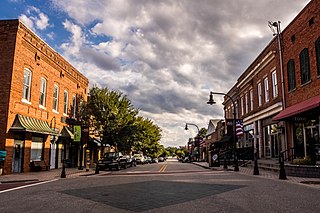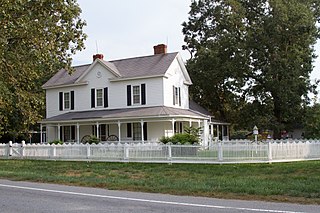
Wake County is located in the U.S. state of North Carolina. In the 2020 census, its population was 1,129,410, making it North Carolina's most populous county. From July 2005 to July 2006, Wake County was the 9th-fastest growing county in the United States, with Cary and Raleigh being the 8th- and 15th-fastest growing communities, respectively.

Wake Forest is a town in Franklin, Granville and Wake counties in the U.S. state of North Carolina; located almost entirely in Wake County, it lies just north of the state capital, Raleigh. At the 2020 census, the population was 47,601. That is up from 30,117 in 2010, up from 12,588 in 2000. The U.S. Census Bureau estimates the city's population to be 47,601 as of April 1, 2020. In 2007, the town was listed by Forbes magazine as the 20th fastest growing suburb in America, with a 73.2 percent increase in population between 2000 and 2006. Wake Forest was the original home of Wake Forest University for 122 years before it moved to Winston-Salem in 1956.

Long Grass Plantation is a historic house and national historic district located along what was the Roanoke River basin. In the 1950s most of it was flooded and became the Buggs Island Lake/John H. Kerr Reservoir in Mecklenburg County, Virginia. The house was built circa 1800 by George Tarry on land belonging to his father, Samuel Tarry, and Long Grass Plantation encompassed approximately 2000 acres (8 km2).

Boone Hall Plantation is a historic district located in Mount Pleasant, Charleston County, South Carolina, United States and listed on the National Register of Historic Places. The plantation is one of America's oldest plantations still in operation. It has continually produced agricultural crops for over 320 years and is open for public tours.

The Mordecai House, built in 1785, is a registered historical landmark and museum in Raleigh, North Carolina that is the centerpiece of Mordecai Historic Park, adjacent to the Historic Oakwood neighborhood. It is the oldest residence in Raleigh on its original foundation. In addition to the house, the Park includes the birthplace and childhood home of President Andrew Johnson, the Ellen Mordecai Garden, the Badger-Iredell Law Office, Allen Kitchen and St. Mark's Chapel, a popular site for weddings. It is located in the Mordecai Place Historic District.

Montfort Hall is a home and registered historic landmark located in the Boylan Heights neighborhood of Raleigh, North Carolina. It is one of the few mansions in Raleigh that survived during the American Civil War era. The house was built for William Montfort Boylan in 1858 and is an example of Italianate architecture. The centerpiece of the house's interior is a rotunda supported by four Corinthian columns and lit by a stained glass window located on the roof. Montfort Hall was listed on the National Register of Historic Places in 1978 as Montford Hall and is a Raleigh Historic Landmark. The building is currently being developed into a 10-room boutique inn.

Falls, is an unincorporated community in Wake County, North Carolina, United States, situated on Old Falls of Neuse Road, between Raleigh and Wake Forest, near the Wakefield Plantation development. Falls Dam, on the Neuse River, is within the community.
The Perry Farm is an intact, historic African-American farm complex in Riley Hill, North Carolina, a suburb of Raleigh. The farm house was built in 1820 by John and Nancy Perry, white slaveholders of several slaves during the Antebellum period of the South.
The Hood–Anderson Farm is a historic home and farm and national historic district located at Eagle Rock, Wake County, North Carolina, a suburb of the state capital Raleigh. The main house was built about 1839, and is an example of transitional Federal / Greek Revival style I-house. It is two stories with a low-pitched hip roof and a rear two-story, hipped-roof ell. The front facade features a large, one-story porch, built in 1917, supported by Tuscan order columns. Also on the property are the contributing combined general store and post office (1854), a one-room dwelling, a two-room tenant/slave house, a barn (1912), a smokehouse, and several other outbuildings and sites including a family cemetery.

This list includes properties and districts listed on the National Register of Historic Places in Wake County, North Carolina. Click the "Map of all coordinates" link to the right to view an online map of all properties and districts with latitude and longitude coordinates in the table below.

The Walnut Hill Historic District is a collection of 40 family dwellings, agricultural outbuildings, and other structures and sites associated with the Walnut Hill Plantation and the Mial-Williamson and Joseph Blake farms near Shotwell, North Carolina. The historic district represents the post-Civil War growth of one of the largest agricultural centers in Wake County. It is situated primarily along the northeast end of Mial Plantation Road between its intersections with Major Slade and Smithfield Roads.

The Hopkins Farm is an agricultural complex listed on the National Register of Historic Places located near the intersection of South Carolina Highway 418 and Fork Shoals Road in the vicinity of Simpsonville, South Carolina. The complex, begun by John Hopkins who purchased the land in 1834 from James Harrison, consists of the main house, a cook's house, agricultural fields, a pecan grove, eleven outbuildings and a family cemetery.
Oaklyn Plantation is a historic plantation and national historic district located near Darlington, Darlington County, South Carolina. The district encompasses 40 contributing buildings, 6 contributing sites, 2 contributing structures, and contributing object. Founded as a forced-labor farm worked by black people enslaved by the land's white owners, it was one of the major plantation establishments of the county and served as the seat of the Williamson family for more than 200 years.

The Crabtree Jones House, also known historically as the Nathaniel Jones Jr. House, is a residence at 3108 Hillmer Drive in Raleigh, North Carolina. Constructed around 1808-1811 by Nathaniel Jones, it is one of the few remaining large scale plantation homes in Wake County, and one of the oldest private residences in Raleigh. The home has received several additions since its initial construction, but is mainly known for its Federal-style front. Owned by the Jones family for more than 150 years, the house has fallen into disrepair in more recent decades. Following the purchase of the land the house sat upon by developers in 2012, Preservation North Carolina acquired the house and had it moved to a nearby residential neighborhood, where it sits today. The Crabtree Jones house was greatly influenced by the historical events it stood through while in turn influencing the way the Raleigh community developed around it, through both its people and through its land.

The Midway Plantation House and Outbuildings are a set of historic buildings constructed in the mid-19th century in present-day Knightdale, Wake County, North Carolina, as part of a forced-labor farm.
Clarkson Farm Complex is a historic farm and national historic district located near Greeleyville, Williamsburg County, South Carolina. It encompasses 8 contributing buildings and 1 contributing site with buildings dating from about 1896 to 1928. They include the main house, store, smokehouse, garage, stable/garage, tenant house, pumphouse, wellhouse and pecan grove. The main house was built about 1905, and is a two-story, frame I-house on a brick pier foundation. The Clarkson Store was built about 1896, and is representative of one of few surviving rural commercial buildings. The pecan grove was planted in 1922.

The Andrews-Duncan House is a historic building located at 407 North Blount Street in Raleigh, North Carolina, United States. Built in 1874 for a prominent businessman, the Italianate style home was designed by architect George S. H. Appleget. The house was added to the National Register of Historic Places (NRHP) in 1972 and is currently owned by the state government. A large tree named after a presidential candidate once stood behind the house and is commemorated with a historical marker.
Dr. Franklin Hart Farm, also known as Hidden Path, is a historic home and farm and national historic district located near Drake, Nash County, North Carolina. It includes a collection of well-preserved mid-19th to early-20th century dwellings and farm outbuildings. The main house was built about 1845, and is a two-story, three bay, single pile I-house with Federal / Greek Revival style design elements. The front facade features a two-tier portico carried by massive, unusual turned and banded columns. Also on the property are the contributing detached kitchen building, smokehouse, seven tobacco barns, corn crib, mule barn, packhouse, and seven tenant houses. The Hart family owned and farmed the land from about 1770 until 1979.

Jesse Penny House and Outbuildings is a historic home and farm complex located near Raleigh, Wake County, North Carolina. The Penny House was built in 1890, and enlarged in 1900. It is a two-story, single pile, frame I-house with a one-story rear addition. It features a hip-roofed wraparound porch. Also on the property are the contributing well house, barn/garage, barn, chicken house, and picket fence.
Purefoy–Dunn Plantation is a historic plantation and national historic district located near Wake Forest, Wake County, North Carolina. The Greek Revival style plantation house was built about 1814 and remodeled about 1850. It is a two-story, L-shaped, heavy timber frame building. It has a low hipped roof and is sheathed in clapboards. The front portico was removed in the 1960s or early 1970s. Also on the property is a contributing mid-19th century gable-roofed frame smokehouse.



















